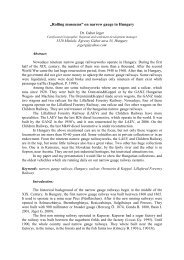'Representing Difficult Pasts within Complex Presents ... - T2M
'Representing Difficult Pasts within Complex Presents ... - T2M
'Representing Difficult Pasts within Complex Presents ... - T2M
You also want an ePaper? Increase the reach of your titles
YUMPU automatically turns print PDFs into web optimized ePapers that Google loves.
Introduction<br />
Museums can be perceived as analogous to artworks (Kirshenblatt-Gimblett 2004:2), stemming<br />
historically from the Kunsthammer, or curiosity cabinet, to the collectively constructed archive of today’s<br />
museum. They involve the reassembling of the world based on speculative ideas which shape a series of<br />
installations, or exhibitions, which claim to represent concrete reality, presenting an inside-out view of<br />
culture (Preziosi 1996). Consequently, museums, whether scientific, or humanities based, present<br />
ourselves to ourselves. They evoke memory and familiarity in our own attempts to construct a ‘history’,<br />
and also notions of difference and otherness, through what is deemed unfamiliar, exotic, geographically<br />
or historically removed, categories shaped through representation which define and imagine communities<br />
of belonging and exclusion (Anderson 1983).<br />
The glass cabinet has been argued to both distance and frame artefacts, fetishizing them by<br />
‘conferring an instant aura of preciousness’ (Henning 2006:8), acting as a lens that ‘sets apart’ objects<br />
from each other. Even the glass case removed does not prevent this distancing <strong>within</strong> the museum context<br />
(Henning 2006:6) – a conundrum which results in, Kirshenblatt (1991) argues, ‘an act of excision, of<br />
detachment, an art of the excerpt. Where does the object begin and where does it end? … Shall we exhibit<br />
the cup with the saucer, the tea, the cream and sugar, the spoon, the napkin and placemat, the table and<br />
chair, the rug? Where do we stop? Where do we make the cut?’ (388) She suggests not the term<br />
‘ethnographic object’, but ‘ethnographic fragment’. These fragments become separated from their original<br />
meanings, argues Strathern (1990), to become marginalised <strong>within</strong> the self-referential domains of a<br />
refined form of aesthetics, ‘The exploration of internal design, the attention to artefact qua artefact, the<br />
preservation of exemplars … a self-referential universe (39). Such fragments become recontextualised<br />
<strong>within</strong> a ‘rhetorics of value’ (Kratz 2011) – processes of circulation, recontextualisation, exhibition<br />
production and interpretation, through museum design, lighting, architecture, labels and texts, which<br />
shape visitor interpretation.<br />
With the above in mind, creating a new museum offers an opportunity for new artistry and a<br />
rethinking of concepts, an opportunity even, to rework tropes of museum-ness, even to turn the museum’s<br />
gaze on itself 1 . The ‘poetics and politics’ (Kratz ibid.) of display can be utilized in such circumstances to<br />
1 A suggestion recently made by Professors Ciraj Rassool and Leslie Witz at a panel discussion concerning<br />
Cape Town’s Iziko Museum’s Social History Collections. Social History Collections: Registering Change in Iziko after<br />
Apartheid. Iziko Slave Lodge. 16 September 2010. Also see Legassick and Rassool 2000 concerning a call for<br />
restitution and de-accession of human remains at Iziko museum. The exhibition ‘Mis-cast’ depicting the storage of<br />
human remains at Iziko also raised similar issues.<br />
2




